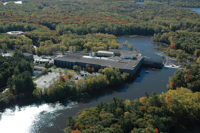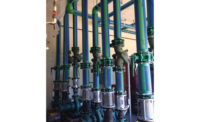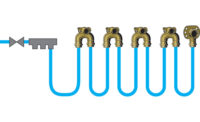For decades, piping systems at wastewater treatment plants have been constructed from a variety of different materials including ductile iron, PVC, concrete, stainless steel, FRP, CPVC, HDPE and other engineered thermoplastics. While each of these materials presents their own benefits, they also have limitations.
Polypropylene-random (PP-R) is a thermoplastic piping material that is relatively new to the United States wastewater treatment market – and it is increasingly being used in WWT applications. This is a natural progression of the material use which is currently in many other applications and thousands of installations across North America.
PP-R is one of the most chemically inert piping materials in use today. It is corrosion-resistant, chemically safe, sustainable and reliable, cost-effective, and can be integrated with other pipe materials such as stainless steel and FRP.
This material is now listed in the ASME piping codes used in WWT facility design, B31.3 for chemical process piping and B31.9 for building services piping. Depending on the jurisdiction, portions of the piping also may fall under the plumbing and mechanical codes where PP-R has been included for many years.
The right fit
Since a failing pipe system at a wastewater treatment plant can result in costly shutdowns, repairs and replacements, potential health hazards and significant environmental impact, appropriate pipe selection is a critical decision.
Manufactured from polypropylene-random copolymer, PP-R is a thermoplastic made of chains of carbon and hydrogen. It is both simple and chemically stable and does not contain harmful chemicals or react with its surroundings.
The “R” in PP-R refers to the random blend of long and short hydrocarbon chains that provides both rigidity and flexibility. It results in a rigid pipe material with strong structural properties that can still bend enough to accommodate some deflection and absorb noise, vibration and pressure surges.
As a hydrophobic material, meaning it repels polar molecules such as water, PP-R does not interact with water. It does not corrode, is very erosion-resistant even in slurry applications, and will not leach, wear out or clog up after a few years of service.
Some pipe manufacturers operating in the U.S. develop and blend their own proprietary PP-R material for different pipe applications. Some of these product offerings also are heat-stabilized to protect the pipe from long-term exposure to temperatures that would damage other plastics, which can be essential in WWT applications such as aeration manifolds and piping where temperatures can exceed 200° F.
PP-R pipe and fittings are fully recyclable, which allows any scrap material to be diverted away from the landfill. Recycled pipe can be ground, melted, and re-used in car parts, home products, packaging and containers. There are no harmful waste products created by the processing or disposal of PP-R.
To facilitate integration with other systems such as stainless steel and FRP, a wide range of transition fittings are available. These transitions include threaded adapters, PEX adapters, flanges and groove adapters. Metal components in the threaded and groove adapters are typically stainless steel or nickel-plated brass. Specialty PP-R threaded adapters also are available for some applications.
Heat fusion provides reliability
PP-R connections are made through heat welding or heat fusion without any adhesives, solvents, solder or mechanical connections. The two PP-R components (e.g. pipe and fitting socket) are simultaneously heated to a “melt” state, joined under pressure, allowed to cool and form a single continuous section of PP-R piping. As the PP-R molecules cool, they bind with each other and turn into one piece, the way they would during extrusion or molding.
Different styles of PP-R heat fusion include socket fusion, outlet fusion and butt welding. Another style is electrofusion, a means of heat fusing pipe and fittings in tight spaces using an electrical current to heat an element embedded in the PP-R fitting. It is mainly for retrofits or instances where other equipment will not fit.
The result is a seamless bond between the materials that possesses the same qualities as the original material and takes from a few seconds on smaller sizes to a few minutes on larger diameters to achieve with no adhesives, solvents, solder or mechanical connections. The fused material has the same chemical structure and strength as the pipe and fittings, so there is no path for leaks or blowouts.
The fittings and joints are designed and tested to ensure they will meet or exceed the pressure ratings of the pipe itself. Because the “joint” is actually just PP-R (such as the fitting and pipe), it provides a certain level of flexibility in the assembled pipe that makes it easy to prefabricate and move on-site without the risk of the joints cracking and leaking. This flexibility and homogeneous joint region also allows for a wider range of applications and protects the pipe from seismic stresses.
For installations with branch lines, fusion outlets offer many advantages over traditional reducing tees. They generate less friction, thus lowering the pressure loss of the entire system. They can be installed in a significantly shorter time than an equivalent size-reducing tee and typically at a much lower cost.
In the plant
PP-R pipe can be safely used in several wastewater treatment applications such as:
• Effluent, or out fall lines;
• Water supply lines;
• Sludge and grit lines;
• Compressed air/aeration lines;
• Chemical supply;
• Vent lines;
• Chemical cleaning lines;
• Exhaust air;
• Lab water (RO/DI); and
• Return-activated sludge lines.
Given its resistance to many types of chemicals, PP-R can be selected for the processing and transport of many aggressive mediums and materials. The specific chemicals, concentrations and use conditions must be evaluated with the manufacturer to ensure the piping is appropriate for the application.
Every piping system – including PP-R – has its limitations, but numerous benefits await innovative wastewater professionals who are willing to consider a proven alternative the status quo.





